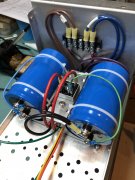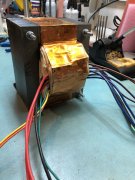Hi Bob
It is not a technology issue at all, no real magic here. It is an economics issue, pure and simple.
I currently own the IP necessary to produce an improved PL700 style transformer.
I designed a replacement PL700 transformer in the same E-I frame size that the original used:
- With a deeper lamination stack to eliminate the high line 50Hz 264VAC saturation issue that the existing transformers have
- With an optimized, lower loss winding to improve the load regulation over the existing
- Added a copper foil flux keeper to minimize stray flux which the existing does not have
- Added an electrostatic shield between primary and secondary which the existing does not have, many medical grade transformers have this feature
- With international windings to support the Japanese 100V market as well as rest of world which the existing does not have
- With computer modeling and simulation that the existing does not have (paid to have this process done)
- With a sheet metal based replacement for the original die cast transformer cradle.
I prototyped this beast of a transformer and the sheet metal cradle replacement and have it on one of my 700 based lab mules. The testing results bore out that it definitely was an improvement over the original. That was the goal and that was accomplished. The primary limiter in achieving
even better results was the base EI frame size that PL originally chose, the window size in the E-I core ultimately limited how good that the transformer could be.
I invested >$2K in the development and prototype fabrication to get to this point.
I quoted the fabrication of this design with 30 transformer suppliers, primarily in the US but a couple in Taiwan.
I considered taking it into production for a while using the transformer manufacturer that made the proto for me. The economics just did not make sense. It would require a MOQ (minimum order quantity) that would tie up a minimum of $7K in capital for a quantity of 25, not including inbound freight which has steadily risen and would be about $35 per item in the best case. It would consume an entire 40" x 48" pallet which would have to be stored somewhere. And that would represent nearly a half a ton in weight making it nearly impossible for me to move once situated.
Add to those costs, the cost of the sheet metal cradle parts.
Add to that, the outbound freight to individual customers would have added another ~$50 in packaging and freight due to the size and weight of each transformer shipped separately. All this long before the current inflation set in.
I rapidly concluded that was a poor business proposition to entertain this thought for me and my customers and decided I had to go in a different direction...
Pics or it didn't happen.
View attachment 75350
View attachment 75351
View attachment 75352



